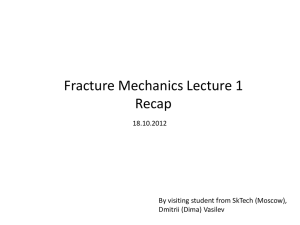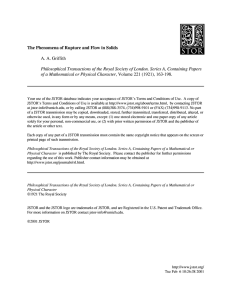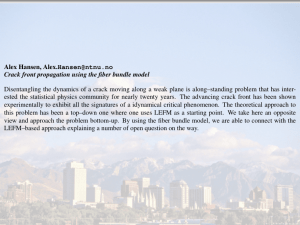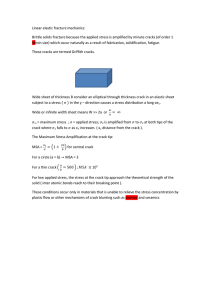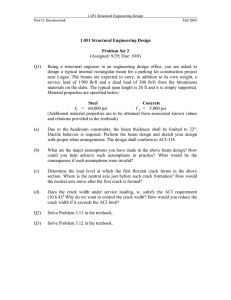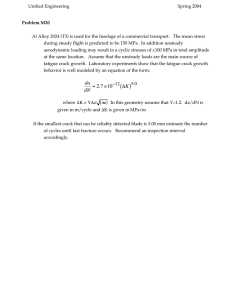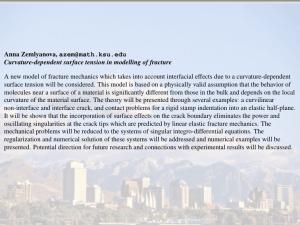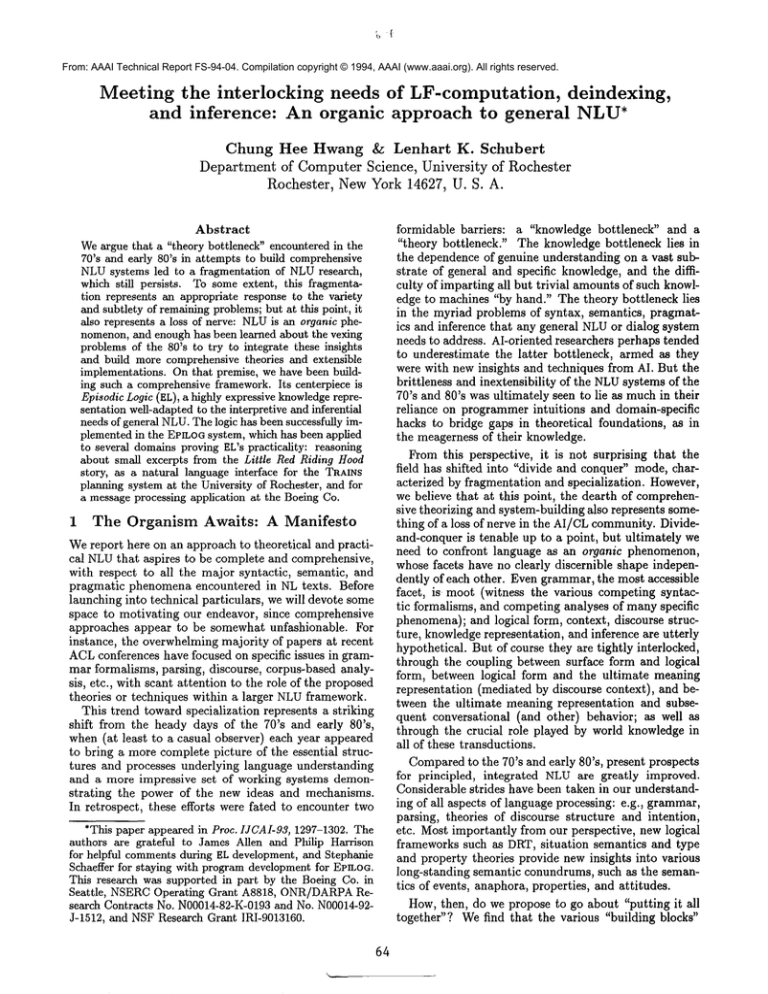
From: AAAI Technical Report FS-94-04. Compilation copyright © 1994, AAAI (www.aaai.org). All rights reserved.
Meeting the interlocking
needs of LF-computation, deindexing,
and inference:
An organic approach to general NLU*
Chung Hee Hwang &: Lenhart
K. Schubert
Department of Computer Science, University of Rochester
Rochester, NewYork 14627, U. S. A.
formidable barriers: a "knowledgebottleneck" and a
"theory bottleneck." The knowledgebottleneck lies in
the dependenceof genuine understanding on a vast substrate of general and specific knowledge,and the difficulty of impartingall but trivial amountsof such knowledge to machines"by hand." The theory bottleneck lies
in the myriad problemsof syntax, semantics, pragmatics and inference that any general NLUor dialog system
needs to address. AI-oriented researchers perhapstended
to underestimate the latter bottleneck, armedas they
were with newinsights and techniques from AI. But the
brittleness and inextensibility of the NLU
systemsof the
70’s and 80’s wasultimately seen to lie as muchin their
reliance on programmerintuitions and domain-specific
hacks to bridge gaps in theoretical foundations, as in
the meagernessof their knowledge.
Fromthis perspective, it is not surprising that the
field has shifted into "divide and conquer"mode,characterized by fragmentationand specialization. However,
webelieve that at this point, the dearth of comprehensive theorizing and system-buildingalso represents some1 The Organism
Awaits:
A Manifesto
thing of a loss of nerve in the AI/CLcommunity.
Divideand-conquer
is
tenable
up
to
a
point,
but
ultimately
we
Wereport here on an approachto theoretical and practineed
to
confront
language
as
an
organic
phenomenon,
cal NLUthat aspires to be complete and comprehensive,
with respect to all the major syntactic, semantic, and whosefacets have no clearly discernible shape independently of each other. Evengrammar,the most accessible
pragmatic phenomenaencountered in NLtexts. Before
is moot (witness the various competingsyntaclaunchinginto technical particulars, wewill devote some facet,
tic formalisms, and competinganalyses of manyspecific
space to motivating our endeavor, since comprehensive phenomena);and logical form, context, discourse strucapproaches appear to be somewhatunfashionable. For
ture, knowledgerepresentation, and inference are utterly
instance, the overwhelming
majority of papers at recent
hypothetical. But of course they are tightly interlocked,
ACLconferenceshave focused on specific issues in gram- through the coupling between surface form and logical
mar formalisms, parsing, discourse, corpus-basedanalyform, between logical form and the ultimate meaning
sis, etc., with scant attention to the role of the proposed representation (mediatedby discourse context), and betheories or techniques within a larger NLUframework.
tween the ultimate meaningrepresentation and subseThis trend towardspecialization represents a striking
quent conversational (and other) behavior; as well
shift from the heady days of the 70’s and early 80’s,
through the crucial role played by world knowledgein
when(at least to a casual observer) each year appeared all of these transductions.
to bring a morecompletepicture of the essential strucCompared
to the 70’s and early 80’s, present prospects
tures and processes underlying language understanding
for
principled,
integrated NLUare greatly improved.
and a more impressive set of working systems demonstrating the power of the new ideas and mechanisms. Considerablestrides have been taken in our understandIn retrospect, these efforts werefated to encountertwo ing of all aspects of languageprocessing: e.g., grammar,
parsing, theories of discourse structure and intention,
*This paper appearedin Proc. IJCAI-93,1297-1302.The etc. Mostimportantly from our perspective, newlogical
authors are grateful to JamesAllen and Philip Harrison frameworkssuch as DRT,situation semantics and type
for helpful comments
during ELdevelopment,and Stephanie and property theories provide newinsights into various
Schaefferfor staying with programdevelopment
for EPILOG. long-standing semantic conundrums,such as the semanThis research was supportedin part by the BoeingCo. in
tics of events, anaphora,properties, and attitudes.
Seattle, NSERC
Operating Grant A8818, ONR/DARPA
ReHow,then, do wepropose to go about "putting it all
search Contracts No. N00014-82-K-0193
and No. N00014-92together"? Wefind that the various "building blocks"
J-1512, and NSFResearchGrant IRI-9013160.
Abstract
Weargue that a "theory bottleneck"encounteredin the
70’s and early 80’s in attemptsto build comprehensive
NLU
systems led to a fragmentationof NLUresearch,
whichstill persists. To someextent, this fragmentation represents an appropriateresponseto the variety
andsubtlety of remaining
problems;but at this point, it
also represents a loss of nerve: NLU
is an organicphenomenon,
and enoughhas beenlearned about the vexing
problemsof the 80’s to try to integrate these insights
and build morecomprehensive
theories and extensible
implementations.Onthat premise, wehave beenbuilding such a comprehensive
framework.Its centerpieceis
EpisodicLogic(EL), a highlyexpressiveknowledge
representationwell-adapted
to the interpretiveandinferential
needsof generalNLU.
Thelogic has beensuccessfullyimplementedin the EPmoG
system, whichhas beenapplied
to several domainsprovingEL’spracticality: reasoning
about small excerpts from the Little RedRiding Hood
story, as a natural languageinterface for the TRAINS
planningsystemat the Universityof Rochester,andfor
a messageprocessingapplication at the BoeingCo.
64
offered by various authors and schools of thought simply
do not fit together in any obvious way, and leave numerous gaps. What we have therefore been attempting is a
creative synthesis of a modularized NLUframework, with
progressive refinement of the overall abstract architecture and gradual "debugging" and theoretical deepening
of the entire account. Lest we lose sight of our computational objectives, we have at all times maintained a tight
link between theoretical development and computer implementation (the latter culminating in the EPILOGreasoning system).
Wefeel that what we have accomplished so far vindicates our methodology. The current framework consists of a GPSG-like approach to grammar with a
Montague-like coupling of phrase structure to logical
form; "preference"-based methods of parsing and scope
disambiguation; a new theory of tense and aspect "deindexing"; a combined semantic representation/knowledge
representation;
and methods of making deductive and
probabilistic inferences in both input-driven and goaldriven modes in this representation. For good reason,
the semantic/knowledge representation, called Episodic
Logic (EL), has turned out to be the centerpiece of our
effort. After all, it is the choice of representation which
determines how easily we can derive content from surface
form, how fully we can capture the semantic nuances of
NL text, and how readily we can perform needed inferences.
2
Representation:
The Central Problem
In speaking of a semantic representation or knowledge
representation, we take for granted that the representation should admit not only straightforward intuitive
interpretation but also a formal denotational semantics.
As long as we remain unclear about what sorts of things
in the world our symbols can stand for, or how a putative knowledge base can conform with (or deviate from)
how things actually are, we risk having the system lapse
into total inconsistency and incoherence for all but trivial knowledge bases. At the same time we should not
from the outset demand absolute hygiene and mathematical perfection from a representational logic which
attempts to encompass all the semantic phenomena of
NL which have occupied linguists and philosophers for
decades, and for which no agreed-upon unified framework exists. In fact, ~.L initially had little more than a
tentative syntax, ontology, and type structure, but we
have now gained an understanding of semantic entailment, finding soundness proofs for someof the inference
methods. In the meantime, however, we have never compromised expressive adequacy for theoretical thoroughness. Instead, all the while, the expressive completeness
of EL has allowed us to experiment freely with the syntax/logical form interface, tense and aspect deindexing,
and inferences based on stories and conversations.
Werecognize that attempts at comprehensive theorizing and system-design have not been completely abandoned. For example, Hobbs et al. [8; 9] and Charniak
et al. [3; 4] have kept their sights on full understanding, and in particular, have made very intriguing proposals for full integration of all types of disambiguation,
65
based on abduction. However, the overwhelming majority of NLUresearchers have in recent years shown a curious reserve toward full understanding, most strikingly
in their approach to the core problem of semantic representation. The existing approaches fall by and large
into either of two categories, theory-free approaches or
FOLapproaches. In a theory-free approach, a representation with no known formal semantics is employed.
Consequently, the user of the representation is free to
claim that a rich variety of concepts and ideas can be expressed in the representation--for instance, beliefs, actions, goals, habitual behavior, etc.- without ever having to confront technical criticisms about internal consistency of the representation, or what follows from given
knowledge. Weare not saying that such work is necessarily bad--it is often quite appealing and persuasive
with respect to the issues it addresses; but the avoidance of the semantic issue, in any serious sense, leaves
the overall frameworkexcessively ill-defined.
FOLapproaches limit the fragments of language considered to those which appear to be expressible in FOL,
at least in rough-and-ready fashion. This has the advantage that FOLis well-understood syntactically and
semantically, but also has the disadvantage that very
little real language is easily expressible in it. Consider,
for instance, the first sentence of the dialog which was
processed by the initial TRAINS-implementation
[1]:
"We have to make orange juice"
This simple sentence exemplifies the following interesting semantic phenomena:it expresses an obligation (and
puts that obligation, in part, on the hearer); it expresses
joint agency; it is tensed (thereby expressing that the
joint obligation is upon the hearer and speaker at the
time of speech); it involves a mass noun phrase, "orange
juice," which on most modern accounts denotes an abstract kind; it involves a verb of creation, "make," which
in combination with its kind-denoting object implies
the coming-into-being of some quantity of orange juice
(this coming-into-being cannot be expressed by existential quantification); and it involves an infinitive whose
interpretation is arguably a reified property. While with
practice one can becomequite good at inventing ad hoc
FOL-approximations to given sentences, it is quite implausible that any reasonably simple, systematic transduction from syntax to semantics would give an FOL
translation of this sentence. Wefind this situation quite
typical for real spoken and written language. So the FOL
approach factors out most of language--at least for any
algorithmic (as opposed to ad hoc) mappingfrom syntax
to semantic representation. Thus, we suggest it is time
to break away from the restrictiveness of FOL, and settle for nothing less than NL-like expressiveness (without
retreating to theory-free representations).
Wenow briefly review EL and its role in a comprehensive, modular approach to NLU.~.L is a first-order logic
that is very expressive, formally interpretable, and easily
derived from surface utterances, yet allows efficient inference. As mentioned, it is based on a Montague-style
coupling between syntactic form and logical form, while
incorporating from situation semantics the idea that sentences describe situations (events, states, episodes, even-
tualities, etc.)? Moreover, all of this is implementedin
at least a preliminary way. The EPILOGsystem [17], the
computer implementation of our logic, makes quite complex inferences, e.g., with utterances from the TRAINS
domain [1], telex reports for aircraft mechanical problems in the ARMS(the Boeing Commercial Airplane Reliability and Maintainability Project) domain [16], and
excerpts from Little Red Riding Hoodstory [19]. The inferences in these experiments are made quite straightforwardly, despite the richness of our logic, or--we would
argue--because of it, and the knowledge they employ
is uncontrived (it corresponds quite directly to English
sentences, and each individual piece of knowledgeis formulated at a maximally general level, rather than being
particularized to the needs of a specific story).
In the rest of this paper, we first describe EL syntax and inference rules, using examples from the ARMS
application domain, and then discuss how one can get
episodic logical form from English input.
3
form of this modal operator is ’*’. [~ , rl] means that
partially describes (or, is true in) r}. This is similar
to the ~ ("support") relation of situation semantics [2;
6], except that we are relating sentence intensions (partial mappings from situations to truth values), rather
than "infons," to situations.
The following examples illustrate attitude predicates
as well as kind abstraction, action abstraction, and event
abstraction.
That, K, Ka, and ge below are nominalization operators: That maps sentence intensions to
propositions, 3 K maps predicates into "kinds" of property, Ka mapspredicates into kinds of action or attribute,
and Ke maps sentence intensions into kinds of event.
¯ The mechanicdoubted that the crack indicated danger.
(3e3:It3 before u3]
[(The x2:[x2 mechanic]
(The y2:[y2 crack]
Ix2 doubt (That (3e4:It4 same-timee3]
[Iv2 indicate (K danger)]** e4]))]))
**e3])
The Episodic Logical Form
The most important feature of EL is its NL-like expressiveness. This makes it easy to derive EL-translations
of English sentences, while also providing a basis for
concise, easily understood inferences. Its syntax allows
lambda abstraction, restricted quantifiers, propositional
attitudes, predicate and sentence modifiers, kind forming
operators, nominalization operators, action abstraction,
DRT-like anaphoric variables, generic conditionals, and
other non-standard constructs. Most importantly, however, it makesuse of episodic variables in the representation of episodic sentences, making implicit temporal and
causal relationships between situations explicit.
To give an idea of the syntax, we show below an ELF
representation of the sentence "A large bird bumpedinto
the left wingof (airplane) VB7,causing it to get a crack"
2(with certain simplifications).
¯ The mechanictried to repair the crack.
(3e5: [es before us]
[(The~: [x~mech~c]
(Theys: [Y3crack] [x3 try (Ka(repair Y3))]))
**e~])
¯ The inspector suggested that an expert examinethe
hydraulic seam.
(Per: It6 before u~]
[(The x4:[x4 inspector]
(The y4:[y4 ((attr hydraulic) seam)]
[x4 suggest
(Ke (3z4:[z4 expert] [z4 examineY4]))]))
**e0])
The DRT-like treatment of indefinites is illustrated by
the donkey sentence, "Every inspector who found a crack
longer than 2 inches immediately reported it":
(Bez: [e~ beforeuT]
[(Vxs: [[x5 inspector]
[(Bex: [el beforeul]
[(The xl: [[zl ((attr left) wing)] A[xl part-of
(3 yl: [yl ((attr large) bird)] [yl bump-into
(Be~:
[[e~before
u~]^ [esdunng
e~]]
[(qys: [[y5 crack]A [(length-of y~ inch) >
**e~])
[~ ~dy~])**es])]
(Be2:It1cause-ofe2] [(Bzl:[zx crack] Ix1 get zl]) ** e2])]
(~eg: It0 imm-afteres] [[xs report Ys] ** eg]))
This sentence introduces three episodes: ul, the utterance event of the above sentence itself; el, an episode of
"large bird Yx bumpinginto the left wing xl"; and e2, an
episode of "wing xl getting crack zl ." Note the clause [el
cause-of e2] that shows the causal relationship between
the two episodes. The occurrence of el outside its quantifier scope is allowed thanks to the parameter mechanism
of EL (more on this later). ’**’ is an episodic modal
operator, such that [¢ ** r/] means formula ~ characterizes (or, completely describes) episode ~7. A weaker
1Weuse the term "episode" to emphasize the transient
nature of the situations that commonly
occur in narratives.
2Below, attr is an operator that transforms a predicate
into an attributive predicate modifier. Notethat we use infix
notation for readability and restricted quantification of the
form(£1 c~: ¢~), whereQ ¯ {V, 3, The, Few,Most,...), c~ is
variable, and restriction ff and matrix fit are formulas. Readers are referred to [10; 12] for details of ELsyntax.
66
**e~]).
Note existential variables y~ and es that occur outside
their quantifier scope. The interpretation of such free
variables is much like that of parameters in DRT. Such
anaphoric variables also play a role in generic conditionals, which, whenused with probabilistic inference rules,
allow us to express unreliable generalizations such as the
following (with somesimplifications).
[(Be[(Bx: Ix crack] [(length-of x inch) < .25]) **
"+.75,e, x [(’-Ix dangerous])* e]]
A crack shorter than 1/~ inch usually is not dangerous.
The subscript ’.75’ in the above conditional indicates
a lower bound on statistical
probability, and e, x are
controlled variables. The rule says, roughly, that in at
3 In ELontology, propositions subsumepossible facts (see
[11; 12; 13]).
least 75%of the cases in which the antecedent is true,
the consequent will also be true.
Weneed to remark here that unlike Davidsonian [5]
event variables, our approach allows for episodes involving quantification, such as "Most planes were more
than 10 years old, which indicated that the airline company had been in financial trouble," or episodes involving negation, such as "The mechanic did not report the
crack; as a result, he was fired." Note that such complex episodes frequently occur as causal antecedents, or
are anaphorically referred to or quantified over, in the
ARMS
(and other) applications.
Our treatment of temporal and locative adverbials
views these as providing conjunctive information about
the described episode, muchas in [7]. For instance, "Airplane VB7 executed an emergency landing in Chicago
yesterday" is represented as
(3el0:[el0
before ul0]
[[[el0 during (yesterday-rel-to Ul0)]
[el0 in-loc Chicago]A
(3x~:[x~ ((nn emergency)landing)]
[VB7execute x6])]
[(Be [(3x: [[x aircraft] A [(age-of x year) <:
(By: [y crack] [y located-on x])) **
**el0]).
Above, nn (standing for noun-noun modification) is an
operator that transforms a predicate to a predicate modifier (aft, the nn operator of nobbs et al. [9]).
Space limitations prevent a discussion of formal semantics (but see [10; 12]), but we should remark that
unlike situation semantics, EL is based on an ontology
that allows possible situations. These are muchlike "partial possible worlds," in that symbolsare assigned partial
extensions (and antiextensions) relative to them.
4
Inference
Rules
in
Episodic
Logic
The main inference rules we have developed are Rule Instantiation (RI) and its dual Goal Chaining (GC), which
resemble forward and backward chaining rules in expert
systems. There is also another class of goal-directed
methods that consists of standard natural deduction
rules such as proving a conditional by assuming the antecedent and deriving the consequent, or proving a universal by proving an arbitrary instance of it. Here we
only discuss RI and GC.
Rule Instantiation(RI)
Rule Instantiation, which is heavily used in input driven
inference, allows arbitrarily manyminor premises to be
matched against arbitrarily
deeply embedded subformulas of a rule. It subsumes modus ponens and modus tollens, but can also instantiate generic conditionals. In
the unit probability version, with just one minor premise
4("fact"), the RI rules are:
R-(¢),
nj( (F:(±)))
+ and - signs are intended to indicate positive and negative occurrence of the embedded ~, ~ formulas being
unified. 5 Unification is defined in a way that allows substitution for explicitly quantified, "matchable"variables.
A variable in a rule or fact is matchableif it is boundby a
positively occurring universal quantifier or negatively occurring existential quantifier. For instance, substitution
of w for x in a positively embeddedsubformula (Vx: [x
P] [z q]) yields [[w P] -+ [w q]], and the same substitution in a negatively embeddedsubformula (Bx: [x P] [x
q]) yields [[w P] A [w q]]. The first rule is sound if
contains no unmatchable free variables which are bound
in F as a whole. The second rule is sound if ¯ contains
no unmatchable free variables which are bound in R as
a whole. So in particular, the first rule is sound if F
contains only constants and top-level universal (hence
matchable) variables. (See [18] for soundness proof.)
As mentioned, the rules also work for generic conditionals, and we illustrate this case. Consider the following generic conditional:
-+.8, e, x (-’ [[Ydue-to(I( corrosion)]*
If an aircraft less than 3 years old has a crack,
usually the crack is not due to corrosion.
Supposenow the translation of a telex contains the following:
[[[VB7aircraft] A [(age-of VB7year) = 2]
[C4 crack] A [C4 located-on VB7]]** Elf
The two year old aircraft VB7has a crack.
Then, RI matches these formulas against the antecedent
of the conditional, unifying VBT/x, C4/y and El/e, and
derives (aided by "specialists" in EPILOG):
(-, [[C4 due-to (I( corrosion)] "s
El,l)
where the superscripted number, .8, is a lower bound
on epistemic probability. (That is, the system concludes
that the crack C4 is not due to corrosion, with minimum
degree of confidence .8.) For this simple example, either version of RI yields the correct inference. This kind
of inference, based on unreliable generalizations, allows
evidence for explanations or predictions to be weighted,
muchas is done in expert systems.
Goal Chaining(GC)
Goal chaining, which dominates goal-driven inference,
is a pair of very general chaining rules. Chaining from
rule consequents to antecedents is a special case. The
following are the GCrules in the unit probability case:
R+(~),
?C+(~)
?. Go,(-~
+
-t(.R~,,
(l)))
F +(Rj
R+(~),
?-1 (.R:,(’~ (O+,(T))))
where ~’ "antiunifies" @, ¯ (i.e.,
where cr unifies ~, ~. R stands for "Rule," and F for
"Fact." T and ± are truth and falsity respectively. The
4R. Waldinger (personal communication)pointed out
us that these rules are essentially the sameas those of Traugott [21], except that we entirely avoid skolemfunctions.
67
with positive existen-
5~ is positively (negatively) embeddedin another formula if the only operators embedding @ are among
{-%-+, A, V, V, B}, and the numberof occurrencesof "%the
antecedent scope of -+, and the restriction scope of V among
the operators embedding¢ is even (odd).
tials and negative universals in G regarded as matchable). R stands for "Rule," and G for "Goal." The first
rule is sound if ¯ contains no unmatchable free variables which are bound in R as a whole. The second rule
is sound if ~ contains no unmatchable (e.g., top-level
universal) variables which are bound in G as a whole.
For example, consider a rule
[(3x1: [xl ((attr hydraulic)joint)]
(3el [(3x2:[x2 crack] [x2 located-onXl]) ** eli))
--~ [(3e2:[e2 same-timeeli [[(age-of xl year) > 5] ** e2])
(3e3:[e3 before eli
[Ix1 receive(K ((attr excessive)pressure))] **
I1 a hydraulic joint has a crack, either it is morethan
5 years old, or received excessive pressure.
Suppose, now, we want to knowif a particular hydraulic
joint, Joint6, received excessive pressure. Then the goal
can be posed as
? (3e: [e before El]
[[Joint6 receive (K ((attr excessive)pressure))] **
with a constraint that E1 is at the same time as the utterance time. Since the goal matches the second disjunct
of the consequent of the rule, with unification Joint6/zl,
El/el, and e/e3, we replace the matching part of the rule
with _1_, and negate the whole formula. Then we get a
new goal
? (-~ [[(3x2:Cx2crack] [x2 located-onJoint6]) **
--+ [(~e2:[e2 same-timeEl]
[[(age-of Joint6 year) > 5] ** e2]) V _1_]]),
which, after simplification,
becomes
? [[(Bx2:[x2crack] [x2 located-on Joint6]) ** El]
(-~(3e~:[e2
same-time
El]
[[(age-of Joint6 year) > 5] ** e2]))].
The new goal says, "Joint6 has a crack and is not older
than 5 years." This makes sense because one way of
proving "Joint6 received excessive pressure" is to prove
that "Joint6 is not older than 5 years and has a crack."
As with the previous RI example, either version of GC
gives us the same new subgoal.
The general version of GCallows arbitrarily manysubsidiary knowledge base facts to be invoked in the process of chaining from the given goal to a subgoal. For
instance, in the above example, knowledge base fact
[Joint6 ((attr hydraulic) joint)] led to immediatesuccess.
For both RI and GC, the second rule remains to be implemented. Yet, the kinds of EL inferences described so
far are carried out efficiently by the EPILOG
system [17],
a hybrid reasoning system combining efficient storage
and access mechanism, forward and backward chaining,
an agenda-driven control structure, and multiple "specialists" for taxonomies, temporal reasoning, etc.
5
Computing Episodic Logical Form
As we have emphasized, a crucial feature of EL with respect to the goal of building general NLUsystems is the
ease with which EL-representations are derived from surface syntax. This is made possible by its NL-like expressiveness.
The initial translation from phrase structure to the
68
preliminary indexical logical form (LF) is accomplished
with GPSG-like syntactic and semantic rules; the final
nonindexical episodic logical form (ELF) is obtained
simple recursive deindexing rules. Such a transformation
is essential because, to be useful for inference, a situational logic need to be nonindexical. Our deindexing algorithm systematically handles tense, aspect, and many
temporal adverbials and their interaction, and brings the
context information into the logical form, removing context dependency.
For example, the logical form of sentence
"A mechanic repaired the crack yesterday"
is easily computedusing the following (somewhatsimplified) lexical and phrase structure rules, annotated with
corresponding semantic rules. (We use a feature system
hierarchically organized as a tree; see [10].)
DET[indef]+-- a; B
DET[def]<--- the; The
N +-- mechanic; mechanic
N e- crack; crack
~ N’ >
NP +-- DET N; <DET
V[past, ANP]+-- repaired; <past repair>
VP +- V[._NB]NP; (V’ NP’)
NP[def-time]6-- yesterday; Yesterday
ADV[ep-mod]
e-- NP[def-time] ; (during NP’)
ADVL[post-mod]+-- hDV[ep-mod];
),PAx ((adv-e ADV’)Ix
VP ~ VP hDVL[post-mod] ; (ADVL’VP’)
S +-- NPVP; [NPt ~]
VP
Applyingthese rules gives us the initial, unscopedlogical
form ULF(1) shownbelow. Angle brackets in (1) indicate
unscoped expressions. Notice the indexical term Yesterday and the indexical sentence operator past in (1). adve (standing for "episode modifying adverbial") is an operator that maps 1-place predicates over situations into
sentential operators. (2) is a scoped LF; past has been
raised so that it has a scope over the whole formula.
The deindexing step from LF (2) to ELF(3) is carried
out by the tense-aspect deindexing rules of ~.L that use
tense trees as componentsof a discourse structure. Note
that the deindexing step introduces an episodic variable
through tense operator past into ELF(3). Also in (3),
indexical constant Yesterday is disambiguated to yesterday relative to the utterance episode, and crack zl is
resolved to Crack8 (the latter kind of reference resolution is not currently dealt with in our system). ,v, is an
extension operator that maps 1-place predicates over situations into sentence intensions. Intuitively, vzr means
zr is true of the current situation, whichis el in this case.
Thus, (3) is identical to (4), which maybe obtained
meaning postulates.
(1) ((adv-e (during Yesterday))
[<3 mechanic> <past repair> <The crack>])
(2) (past ((adv-e (during Yesterday))
(Thexl: Ix1 crack]
(3y1: [yl mechanic][yl repair xl]))))
(3) (3el:[el
before
[[V(during(yesterday-rel-to ul))
(3yl :[Yl mechanic][ylrepair CrackS])]
**el])
References
(4) (3el:[ex before
[[[el during (yesterday-rel-to u~)]
(3yt:[yt mechanicl[ylrepair Crack8])]
**e~])
Our deindexing mechanism is compositional in that
operators past, futr, perf, etc., contribute separately and
uniformly to the meanings of their operand formulas,
driving the generation and traversal of tense trees in
deindexing. As an example, we show the Past-rule below.
Past: (past ¢)T
e+ (3eT:[[e T befT EmbT]A [Last¢, T orients
eT]
]
[~o¢’T ** eT])
Treetransform:(past ¢)" r = t(¢" (o~/r))
T denotes a tense tree, eT a "new" episode symbol (i.e.,
not yet used in T). EmbT,LaStT, c/T, OT, etc., are easily computed functions on the tense tree (see [14] for
details). The recursively deindexed ff is taken to characterize the new episode eT, which is predicated to be at
or before ("befT") the embeddingepisode EmbT,e.g., the
utterance event (depending on the aspectual class of
and other factors). Tense trees also provide the "points
of orientation" (cf., [15; 22]), such as the reference point
for a perfect episode or the immediately preceding past
episode in a succession of simple past-tensed sentences,
and the "orients" predication captures this.
As mentioned, the information in the past operator
and in the time adverbial are essentially interpreted conjunctively as in [7]. For detailed discussion of the interpretation of temporal and other adverbials, see [10;
14]. Although we do not yet have grammars and LF
rules for large subsets of English, the compositional approach of EL has been proven practical by a start-up implementation that has successfully handled dialogues in
a planning system in the TaAINSdomain[1]. See [10] for
some of our grammar fragments. The ARMSapplication
used a grammar and interpretation
mechanism internal
to the Boeing Co.
6
Concluding Remarks
Wethink there is cause for optimism about the possibility of constructing theoretical and computational frameworks for full NLU.Our ownefforts in that direction have
led to a rather well-integrated conception of syntax, LF,
knowledgerepresentation, context, and inference, and of
the interfaces linking these into an organic whole. The
conception is not yet complete or fully "debugged," but
it is sufficiently far along to have provided a basis for
diverse start-up implementations. Unlike most past implemented NLUand inference systems, these implementations strenuously avoid cutting corners in syntax, LF
computation, and most of all, knowledge representation
and inference. Thus, we have reason to regard the theoretical framework and the implementations as a solid
and extensible basis for further work toward the ultimate goal of general NLU.
69
[1] J. Allen & L. K. Schubert. The TRAINSProject. TR
382, U. of Rochester, 1991.
[2] J. Barwise. The Situation in Logic. CSLI,Stanford, 1989.
[3] E. Charniak. Motivation analysis, abductive unification, and nonmonotonic
equality. Artificial Intelligence,
34:275-295, 1988.
[4] E. Chamiak& R. Goldman.A logic for semantic interpretation. In Proc. 26th Annual Meeting of the ACL,
87-94, Buffalo, NY,1988.
[5] D. Davidson. The logical form of action sentences. In
N. Rescher, editor, The Logic of Decision and Action.
U. of Pittsburgh Press, 1967.
[6] K. Devlin. Logic and Information. CambridgeU. Press,
UK, 1991.
[r] D. Dowty. Tense, time adverbs and compositional semantic theory. Linguistics ~ Philosophy, 5:23-55, 1982.
[8] J. R. Hobbs, W. Croft, T. Davies, D. Edwards, &
K. Laws. Commonsense
metaphysics and lexical semantics. ComputationalLinguistics, 13:241-250, 1987.
[9] J.R. Hobbs, M. Stickel, P. Martin, &D. Edwards. Interpretation as abduction. In Proc. 26th AnnualMeeting
of the ACL,95-103, Buffalo, NY,1988.
[lO] C. H. Hwang.A Logical Approach to Narrative Understanding. PhDthesis, U. of Alberta, Canada, 1992.
[11] C. H. Hwang&L. K. Schubert. EL: A formal, yet natural, comprehensiveknowledgerepresentation. In Proc.
AAAI-93, 676-682. Washington, DC, 1993.
[12] C.H. Hwang& L. K. Schubert. Episodic Logic: A situational logic for natural languageprocessing. In Situation
Theoryand its Applications, 1I. 3, CSLI,Stanford, 303338.
[13] C. H. Hwang&L. K. Schubert. Episodic Logic: A comprehensive, natural representation for language understanding. Minds and Machines, V. 3, 381-419.
[14] C. H. Hwang&L. K. Schubert. Interpreting tense, aspect and time adverbials: A compositional, unified approach. In Proc. 1st lnternat. Conf. on TemporalLogic
(ICTL ’94), 238-264. Bonn, Germany,1994.
[15] G. Leech. Meaningand the English Verb (2nd ed). Longman, London, UK, 1987.
[16] A. Namioka, C. H. Hwang,& S. Schaeffer. Using the
inference tool EPILOG
for a messageprocessing application. lnternat. J. of Expert Systems, In print.
[17] S. Schaeffer, C. H. Hwang,J. de Haan, &L. K. Schubert.
The User’s Guide to EPILOG.Edmonton,Canada, 1991.
[18] L. K. Schubert. Formal foundations of Episodic Logic.
In preparation.
[19] L.K. Schubert & C. H. Hwang.An Episodic knowledge
representation for narrative texts. In Proc. 1st lnt.
Conf. Principles of KnowledgeRepresentation ~ Reasoning (KR ’89), 444-458, Toronto, Canada, 1989.
[20] L.K. Schubert & C. H. Hwang.Picking reference events
from tense trees: A formal, implementabletheory of English tense-aspect semantics. In Proc. Speech and Natural Language, DARPA
Workshop, 34-41, Hidden Valley,
PA, 1990.
[21] J. Traugott. Nested resolution. In Proc. 8th International Conference on Automated Deduction (CADE-8),
394-402. Springer-Verlag, Oxford, UK,1986.
[22] B. L. Webber. Tense as discourse anaphor. Computational Linguistics, 14:61-73, 1988.

